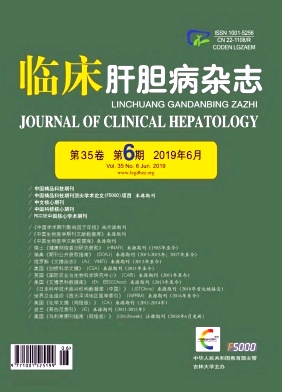|
[1]HASHIMOTO E, TANIAI M, TOKUSHIGE K.Characteristics and diagnosis of NAFLD/NASH[J].J Gastroenterol Hepatol, 2013, 28 (Suppl 4) :64-70.
|
|
[2]FARRELL GC, CHITTUR S, LAU GK, et al.Guidelines for the assessment and management of non-alcoholic fatty liver disease in the Asia-Pacific region:Executive summary[J].J Gastroenterol Hepatol, 2007, 22 (6) :775-777.
|
|
[3]BYRNE CD, TARGHER G.NAFLD:A multisystem disease[J].JHepatol, 2015, 62 (1) :s47-s64.
|
|
[4]MISHRA A, YOUNOSSI ZM.Epidemiology and natural history of nonalcoholic fatty liver disease[J].J Clin Exp Hepatol, 2015, 35 (3) :221-235.
|
|
[5]FAN JG, FARRELL GC.Epidemiology of non-alcoholic fatty liver disease in China[J].J Hepatol, 2009, 50 (1) :204-210.
|
|
[6]CHALASANI N, YOUNOSSI Z, LAVINE JE, et al.The diagnosis and management of non-alcoholic fatty liver disease:Practice Guideline by the American Association for the Study of Liver Diseases, American College of Gastroenterology, and the American Gastroenterological Association[J].Hepatology, 2012, 55 (6) :2005-2300.
|
|
[7] BHANJI RA, NARAYANAN P, ALLEN AM, et al.Sarcopenia in hiding:The risk and consequence of underestimating muscle dysfunction in NASH[J].Hepatology, 2017, 66 (6) :2055-2065.
|
|
[8]LIOU I, KOWDLEY KV.Natural history of nonalcoholic steatohepatitis[J].J Clin Gastroenterol, 2006, 40 (Suppl) :s11.
|
|
[9]CHEN LK, LIU LK, WOO J, et al.Sarcopenia in Asia:Consensus report of the asian working group for sarcopenia[J].JAm Med Dir Assoc, 2014, 15 (2) :95-101.
|
|
[10]KIM H, HIRANO H, EDAHIRO A, et al.Sarcopenia:Prevalence and associated factors based on different suggested definitions in community welling older adults[J].Geriatr Gerontol Int, 2016, 16 (Suppl 1) :110-122.
|
|
[11]Chinese Society of Osteoporosis and Bone Mineral Research.Consensus statements on sarcopenia[J].Chin J Osteoporosis Bone Miner Res, 2016, 9 (3) :215-227. (in Chinese) 中华医学会骨质疏松和骨矿盐疾病分会.肌少症共识[J].中华骨质疏松和骨矿盐疾病杂志, 2016, 9 (3) :215-227.
|
|
[12] CRUZJENTOFT AJ, KIESSWETTER E, DREY M, et al.Nutrition, frailty, and sarcopenia[J].Aging Clin Exp Res, 2017, 29 (1) :1-6.
|
|
[13]CHEN YL.Research of the current suitation and mechanism of sarcopenia[J].Fudan Univ J Med Sci, 2016, 43 (6) :751-756. (in Chinese) 陈玲燕.肌少症的现况调查及发病机制研究进展[J].复旦学报:医学版, 2016, 43 (6) :751-756.
|
|
[14]HONG HC, HWANG SY, CHOI HY, et al.Relationship between sarcopenia and nonalcoholic fatty liver disease:The Korean Sarcopenic Obesity Study[J].Hepatology, 2014, 59 (5) :1772-1778.
|
|
[15] KOO BK, KIM D, JOO SK, et al.Sarcopenia is an independent risk factor for non-alcoholic steatohepatitis and significant fibrosis[J].J Hepatol, 2017, 66 (1) :123-131.
|
|
[16]KALYANI RR, CORRIERE M, FERRUCCI L.Age-related and disease-related muscle loss:The effect of diabetes, obesity, and other diseases[J].Lancet Diabetes Endocrinol, 2014, 2 (10) :819-829.
|
|
[17] MARTIN V, GONZALEZ R, MENDOZA J, et al.Pathogenesis, diagnosis and treatment of non-alcoholic fatty liver disease[J].Rev Esp Enferm Dig, 2013, 105 (7) :409-420.
|
|
[18] PEDERSEN BK, FEBBRAIO MA.Muscles, exercise and obesity:Skeletal muscle as a secretory organ[J].Nat Rev Endocrinol, 2012, 8 (8) :457-465.
|
|
[19]MILLER AM, WANG H, BERTOLA A, et al.Inflammation-associated interleukin-6/signal transducer and activator of transcription 3 activation ameliorates alcoholic and nonalcoholic fatty liver diseases in interleukin-10-deficient mice[J].Hepatology, 2011, 54 (3) :846-856.
|
|
[20]ZHANG HJ, ZHANG XF, MA ZM, et al.Irisin is inversely associated with intrahepatic triglyceride contents in obese adults[J].J Hepatology, 2013, 59 (3) :557-562.
|
|
[21] BOSTROM P, WU J, JEDRYCHOWSKI MP, et al.A PGC1-α-dependent myokine that drives brown-fat-like development of white fat and thermogenesis.[J].Nature, 2013, 481 (4) :463-468.
|
|
[22] HONDARES E, POSELL M, DIAZDELFIN J, et al.Peroxisome proliferator-activated receptorα (PPARα) induces PPARγcoactivator 1α (PGC-1α) gene expression and contributes to thermogenic activation of brown fat:Involvement of PRDM16[J].J Biol Chem, 2011, 286 (50) :43112.
|
|
[23]STIENSTRA R, SAUDALE F, DUVAL C, et al.Kupffer cells promote hepatic steatosis via interleukin-1β-dependent suppression of peroxisome proliferator-activated receptorαactivity[J].Hepatology, 2010, 51 (2) :511-522.
|
|
[24]MERLI M, DASARATHY S.Sarcopenia in non-alcoholic fatty liver disease:Targeting the real culprit?[J].J Hepatology, 2015, 63 (2) :309-311.
|
|
[25]GARCIA, PAUL S, CABBABE, et al.Elevated myostatin levels in patients with liver disease:A potential contributor to skeletal muscle wasting[J].Anesth Analg, 2010, 111 (3) :707-709.
|
|
[26]DASARATHY, SRINIVASAN.Is the adiponectin-AMPK-mitochondrial axis involved in progression of nonalcoholic fatty liver disease?[J].Hepatology, 2014, 60 (1) :22-25.
|
|
[27] HAN S, CHIANG JYL.Mechanism of vitamin d receptor inhibition of cholesterol 7-hydroxylase gene transcription in human hepatocytes[J].Drug Metab Dispos, 2009, 37 (3) :469-478
|
|
[28]DUNLOP TW, VAISANEN S, FRANK C, et al.The human peroxisome proliferator-activated receptor delta gene is a primary target of 1alpha, 25-dihydroxyvitamin D3 and its nuclear receptor[J].J Mol Biol, 2005, 349 (2) :248-260.
|
|
[29]ELIADES M, SPYROU E, AGRAWAL N, et al.Meta-analysis:Vitamin D and non-alcoholic fatty liver disease[J].Aliment Pharmacol Ther, 2013, 38 (3) :246-254.
|
|
[30] RIACHY R, VANDEWALLE B, CONTE JK, et al.1, 25-dihydroxyvitamin D3 protects RINm5F and human islet cells against cytokineinduced apoptosis:Implication of the antiapoptotic protein A20[J].Endocrinology, 2002, 143 (12) :4809-4819.
|
|
[31] MOLINARO F, PASCHETTA E, GAMBINO R, et al.Gut Microbiota as a modulator of cardiometabolic risk:Mechanisms and therapeutic implications[J].Curr Cardiovasc Risk Rep, 2012, 6 (1) :71-79.
|
|
[32]XIA F, ZHOU BJ.Role of gut-liver axis dysfunction in pathogenesis of non-alcoholic fatty liver disease:Implications for treatment strategies[J].World Chin J Dig, 2018, 26 (24) :1439-1447. (in Chinese) 夏凡, 周本杰.肠-肝轴功能紊乱在非酒精性脂肪肝病发病机制中的作用及相关治疗策略[J].世界华人消化杂志, 2018, 26 (24) :1439-1447.
|
|
[33]SINAL CJ, TOHKIN M, MIYATA M, et al.Targeted disruption of the nuclear receptor FXR/BAR impairs bile acid and lipid homeostasis[J].Cell, 2000, 102 (6) :731-744.
|







 DownLoad:
DownLoad: